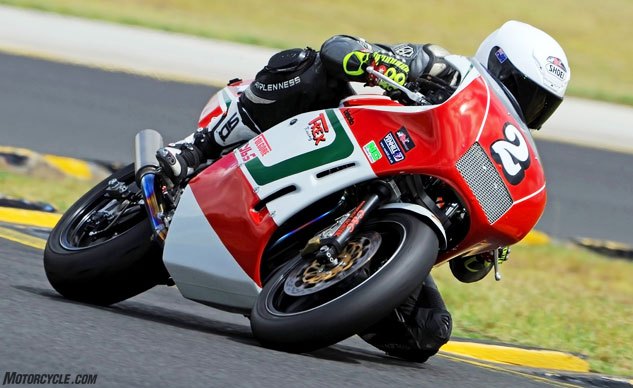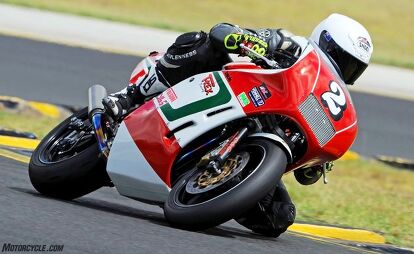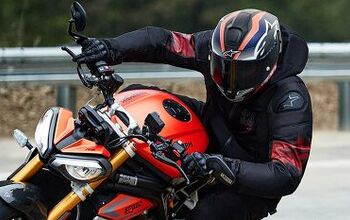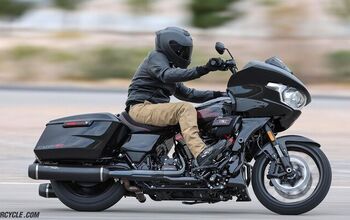1987 Bimota YB5 Racer Tested On Track
The Bimota YB5 was tagged as the fastest, maddest, most expensive hyperbike on the planet when it was rolled out in 1987. With 130-horsepower from the amazing FJ1200 engine, the YB5 was what the Hayabusa is now, only with the flair and exclusivity that comes with a bike that is hand built and one from a run of only 208 units.
The original YB5 was very trick for the era, with a chro-moly steel cradle frame running machined billet alloy sideplates. It ran a high-end Marzocchi 42mm fork, Brembo brakes and retailed for a then-stratospheric $11,000 USD. It was one of the most amazing, expensive, out of this world and radical motorcycles on the planet.
It was fast – real fast – and it handled almost like a 250 despite housing a massive lump of an engine from a Yamaha FJ1200. By 1988, the production run was over and lucky collectors had a true piece of history.
Almost 30 years later, the YB5 legend remains, but it’s almost impossible to find one today. It took T-Rex Racing’s Rex Wolfenden an eternity to find himself an immaculate low-mileage example. He got hold of one and landed it on the bench in his immaculate Melbourne, Australia, workshop that is famous Down Under for building championship-winning motorcycles, particularly specializing in Honda 750 Fours of the classic Forgotten Era class.
The Barry Sheene Festival Of Speed features many of Rex’s bikes, which usually win a few classes including the Barry Sheene this year with rider Chas Hern taking the weekend on this very bike.
Barry Sheene Festival Of Speed 2016
Rex stripped it immediately and began the process of turning into what we think is the only YB5 racebike in the entire world. If there is another, we can’t find it!
He first removed the standard FJ1200 engine and built it to his specification. He bored it an extra 1mm and fitted JE forged pistons to Carrillo conrods, which swing off a lightened and balanced crankshaft on oversized main bearings. The cylinder head was reshaped and ported by Rex, who also installed oversized valves actuated by camshafts of his own specification. The original five-speed gearbox was undercut, and a slipper clutch was fitted to the bike post my test (you can see the hop into turns in our onboard video above).
Feeding the FJ engine are four Keihin 37mm CR carburetors. Mixture is fired by a Dyna 2000 ignition system and gasses exit via a stunning Over Racing Titanium four-into-one exhaust system and T-Rex alloy muffler. As you can hear in the video, the sound is out of this world…at both ends!
With a comfortable 150-horsepower at the rear wheel, the chassis now needed setting up. Rex braced the spindly chro-mo swingarm heavily, but aside from that, the amazing YB5 frame is standard. The Marzocchi fork was replaced by a 43mm Kayaba unit with T-Rex valving and springs. At the back end, a custom Ohlins shock was fitted via T-Rex linkages. Wheels at both ends are cast alloy ZX-12 items, while the old Brembo brakes were exchanged for more modern four-piston Brembo calipers. These squeeze SBS race-compound brake pads onto semi-floating stainless-steel NG rotors via Venhill brake lines. Tires are Pirelli slicks.
With the rolling chassis complete and the engine slotted back in, Rex got to work on the controls, brackets and fairings.
The original fairing was cut up (ouch!) and molds were taken off it to make a set of race fairings. These are wafer thin and ultra lightweight. The single-seat unit is a work of art, and the way Rex has retained the profile of the original fuel cell cover is a nice touch.
The steel fuel tank was replaced by an aluminum item made by Rex’s brother (and ex-Honda Factory Superbike team manager) Clyde Wolfenden, at C&C Motorcycle Engineering. Clyde also knocked up the rearsets, ’bars and other billet bits and pieces. I think you’d have to agree, it is an absolute stunner of a bike.
The bike debuted at the 2016 Phillip Island World Superbike round in February, where Rex slotted it up in the back of his garage and quietly entered it in the support races. His hope of anonymity was short lived, as soon the bike was the talk of the paddock and there were swarms of people looking at it.
A few months later after some more development, the bike was raced in anger at the 2016 Barry Sheene Festival Of Speed. Originally penciled in as a back-up bike for rider Chas Hern, who planned on running Rex’s Harris Honda, Chas soon found he was faster on the Bimota. So he chose that and won the weekend convincingly. No mean feat. The lap times were only seven seconds off domestic factory superbike record times.
The Ride
It was the Thursday before the BSFS that I had the opportunity to try out this amazing motorcycle that I had already drooled over at Phillip Island.
Having ridden Rex’s Harris Honda, I knew the bike would be good. Plus, with such an exclusive and irreplaceable bike, I was not too nervous about the test and damaging the machine as, like the Harris Honda, I could tell by watching it in action that I was going to feel comfortable on the bike within three or four corners. And I was right.
Rex has an ability to make a bike behave in a way that makes the rider confident and comfortable. It’s a knack that takes most of the hard work out of going fast before even sitting on the bike.
Hopping on, the bike feels narrower than it looks, although it is still wide. The recess in the fuel tank cover is immediately annoying. The pegs are high and wide and feel good, the ’bars really wide but with a good angle and draw. The screen is enormous – when you are used to the miniscule screens these days. Reminds me of my 1985 GSX-R750.
With the bike fired up on the roller (starter motor removed), I select first via the reverse-shift lever and head out of pit lane. The exhaust note is deep and angry. The bike is actually a little intimidating to be honest!
However, I roll out onto the circuit and, as expected, within four corners my knee is on the ground and I feel like I have ridden this bike many, many times. I’m at home.
Before I can fully explore the glorious torque of the T-Rex FJ engine, I start to get a feel for the chassis dynamics and immediately feel there is a problem at the back with the tire. The rear feels like it is sitting low and there is a hesitation on initial turn-in, caused by the rear tire shape. It is also spinning up in a big way off turns.
I stay out for the session to get photographs for the test and try to use the time to test the brakes, suspension and that stunning engine. On return Rex agrees that the tire is probably not right and swaps it for a new slick.
The profile lifts the bike and transforms it to heaven on two wheels. It’s a little taller at the back, but the tire is also more triangulated.
Stability on the brakes is impressive aside from some rear chatter caused by engine braking; remember my test was before a slipper clutch was added. The brake package is fantastic, and I’m surprised how good the Nissin master cylinder works, with good initial bite, feel and modulation at the lever.
Braking hard on turn-in is the best way to get the stable set-up into the turn quickly, along with a heap of muscle. But once that initial turn and commitment is made, the YB5 falls very gracefully on its side with absolute surprise-free progression. It’d help if I could get further forward, but I would not sacrifice that original tank profile to do it.
Once leaned over, I could just about take my hands off the ’bars it was so stable. The bike sits at full lean, planted, with incredible grip and turn of speed. It thrives on old-school fast lines, which suits me fine.
Cracking the quick-action throttle is just a real pleasure, as the perfectly set-up Keihin CRs gently feed on, the cams coming in nicely. Just before the apex, I could wind it on hard and have it at full throttle exiting the turn, the Pirelli hooking up and driving the YB5 forward. It was like being fired out of a cannon!
The front wheel paws for the sky in this situation, and as I tuck in and grab another gear on the slick-shifting ’box, I can’t help but smile. It reminds me of watching the onboard footage of early-era superbike races. I feel like Spencer, Rainey or Lawson heading onto the banking at Daytona… I just love these bikes so much. They have true character.
The power and torque is proper old school – no electronics. It is serious fun. From idle to 9000 rpm, you better hold on because this Bimota will get you to the next braking zone in a hurry. Clicking through the gears at full throttle, with a sharp pop to the next gear after a roll off of the throttle, I’m amazed at just how quickly the bike accelerates. It would eat any modern Japanese 1000 for lunch, sucking it up in the intake and spitting it out the exhaust pipe.
The riding experience of the T-Rex Racing Bimota YB5 was a memorable one and a true pleasure. I would not change it much at all, if anything, perhaps getting it a tiny bit more raceable in the steering geometry, but that might take away the rock-solid stability. Rex is already working on this with Chas.
I would rate this bike as one of the best handling motorcycles I have ridden in my career, and it is not that much younger than I am! If only Rex was mass-producing these amazing motorcycles – I’m sure there’d be 40-something year-old riders whipping credit cards out all over the world…
Stunning. There is no other word for it.
1987 Bimota YB5 Specifications | |
|---|---|
| Engine | 1988 Yamaha FJ1200 engine, standard 63.8mm stroke, 1mm over 78mm bore, 11:1 compression up from 9:1, polished and modified standard crankcases, lightened and balanced crankshaft, Carrillo conrods, JE forged pistons, T-Rex Racing camshafts, T-Rex Racing cylinder-head porting and reshaping, oversized EX and IN valves, standard oil cooler and galleries |
| Power (Claimed) | 150-plus hp at the wheel |
| Fuel System | Keihin 37mm CR carburetors |
| Ignition | Dyna 2000 ignition system |
| Transmission | Standard five-speed gearbox with gears undercut, slipper clutch, |
| Exhaust | Over Racing Ti exhaust system, T-Rex Racing muffler |
| Fuel Tank | Alloy |
| Frame | 1988 Bimota YB5 double cradle chro-mo frame and swingarm with T-Rex swingarm bracing |
| Front Suspension | 43mm KYB fork with T-Rex valving, 1kg springs, 7wt oil |
| Rear Suspension | Ohlins shock |
| Front Brakes | Brembo four-piston calipers, NG semi-floating rotors, SBS brake pads, Venhill line, Nissan master-cylinder |
| Rear Brakes | Brembo caliper, NG rotor, Venhill line |
| Rake | 23.5-degrees |
| Trail | 112mm |
| Wheelbase | 57.3 inches |
| Weight | 410 lbs dry |
| Other | C&C Engineering levers, rearsets, handlebars, fairing brackets remade Bimota bodywork |
More by Jeff Ware


































































Comments
Join the conversation
410lbs dry with an FJR engine.... impressive! Sounds like it was a real hoot to drive.
It truly is a beautiful bike with a stonking engine. I have one of the 208 in original unmolested condition & its quietly hidden in a shed up here in QLD. You'll see it occasionally getting ridden around the sunny coast. Personally, I love the mods that have been done to the race bike. They are bang on and imo perfect for the period. Anoraks measuring the thickness of the fairing will argue that the bike has been molested but this is not the case. The designers built these things to be ridden and hopefully raced - not to sit in museums. That was ALWAYS the intention. Is it better that they are hidden away or used? I believe the later and if anything the mods done along with genuine racing provenance of winning the Barry Sheene should improve the value and also the mystique of what is truly a wonderful bike to look at (and if you are super lucky) own & ride. Well done T-Rex.